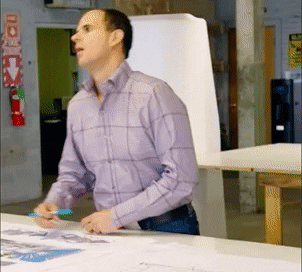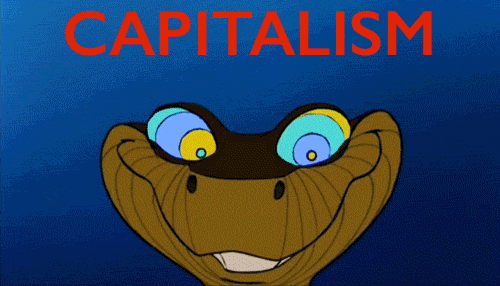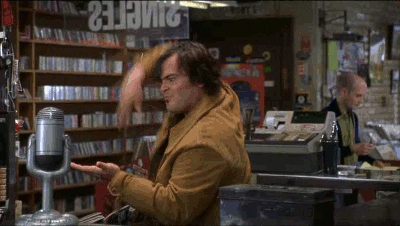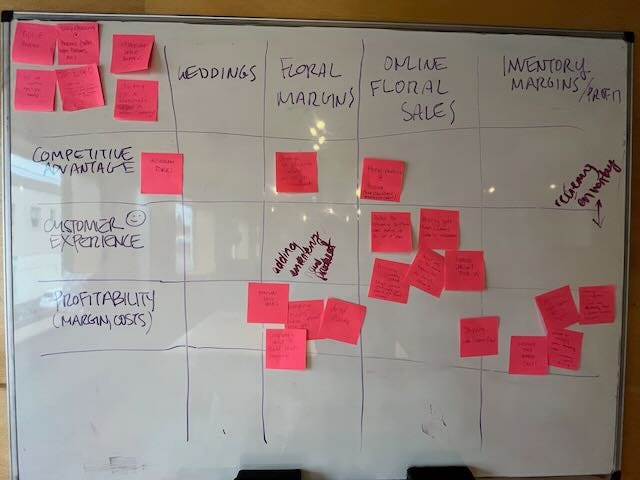Four years in business, and what have I learned?
People, product, process, and profit. What's next?
Fernseed has officially been in business 4 years now, and in the process of celebrating and posting about our anniversary on Instagram, I had the opportunity to look back at photos from years past, a tangible reminder of just how far we've come.
This week I thought I'd write about what I've learned in those 4 years and what I'm still learning. To simplify that huge topic, I’m breaking it into four categories: people, process, product, and profit.
Why people, process, and product?
One of my favorite business shows of all time is The Profit on CNBC. It's kind of like Kitchen Nightmares but not just for restaurants, and although it's a reality show, it's not too terribly gimmicky. The host, Marcus Lemonis, is a business owner, investor and advisor who systematizes business improvements in his consulting practice by identifying strengths and weakness within three categories: people, product, and process. I crave categories and systems, so I love this approach and use it at Fernseed when I tackle big projects like writing an employee handbook.
Where profit comes in
As I've written about before, I'm also a devotee of Mike Michalowicz, business owner and author of multiple business books including Profit First, which changed my life. (I'm reading my way through his entire catalog now, currently halfway through Fix This Next.) Because of Mike Michalowicz I've added a fourth "p" word to the categories of business I focus on: profit.
I know some people have a complicated relationship with profit because capitalism, but Michalowicz's approach isn't about hoarding money at the top. It's a practical system for limiting expenses, finding more revenue in the couch cushions, and allocating money to different buckets (separate bank accounts) so you can confidently control cash flow and, most importantly, earmark a portion of your revenue as “profit” that you set aside so it actually exists in a separate bank account when your accounting reflects a profit. (If you struggle with budget, making payroll, setting aside money for taxes, or are still trying to figure out where the money went by asking your accountant or bookkeeper, you must read Profit First, I command you!)
Enough media plugs, though. Let’s dive into the learning.
People
I never managed people before I started Fernseed. I would not advise tackling your first people management job within the context of starting your own company. I think having prior experience managing people and teams, and probably hiring and firing, is essential when starting a business. I learned as a trial by fire.
The first thing I learned was that I could not manage by being everyone's friend. I know anyone with management experience is saying, "Yeah, duh,” here, but think about the images we get of small businesses from movies and television. It's always a group of people just hanging out, shooting the shit.
This is not reality! Nor should it be your goal. You can be on great terms with your staff, but you have to maintain professional boundaries, without which you develop conflicts of interest. It's hard to effectively manage someone when either of you are sharing information about your life that should be reserved for therapists or bffs.
That's not to say that these lines don't get blurred a little bit in small businesses. They do! When you work alongside a small group of people 30-40 hours per week, conversations can drift into the personal. Storefront businesses have a lot more water cooler time than corporate cubicle work. To be clear, I think some of that is okay! If my team wants to talk about bad breakups while building floral arrangements, that's fine. I may even chime in! But I've learned that I have to set the tone, and check in with people about recalibrating what is and isn't appropriate in our current team dynamic. I'm also careful to only share personal information in a group context rather than one-on-one conversations, so it's clear that I'm just participating in banter versus burdening an individual with my personal issues.
I know this all sounds like a robot learning how to be human, but I am an over-sharer by nature (see: this newsletter), and this is hard for me! But I remind myself that the more I err on the side of professional discretion, the easier it is to have difficult management conversations with people when they come up, and I'll take all the help with difficult management conversations that I can get! It's like I'm buying insurance for future managerial ease.
Product
If I look back at photos of the shop when we opened, I am shocked at some of the product and merchandising choices I made at the beginning. But here's the thing: I've learned that it takes years to develop a good buying muscle for a particular business, and you can only do it through trial and error. You will make mistakes by buying merchandise that doesn't sell. You'll also change your aesthetic over time. I think it's helpful to define some core principles around what you're looking for and why, but beyond that, allow the merchandise to shift and change the way your clothing does. Are you wearing the exact same outfits you were 5 years ago? Probably not. You might own a lot of the same pieces in your core wardrobe, but cringe at a shirt you’re wearing in an old photo. Totally normal!
One thing I'm working on now that took four years of learning is maintaining the right level of inventory so we're not out of things, but we don't have too much overstock. For example, our inventory manager and I are further limiting the color and size options we purchase from popular lines. If we have beige, do we need gray? This is easier with pottery than it is with clothing, especially where size inclusivity is involved, but each shop needs to find their own balance.
If you want to read more on that, I wrote extensively about the challenge of stocking inventory that reflects your values in a previous post.
Process
The first person I ever hired at Fernseed had zero retail experience outside of working at a liquor store. I hired them in part because they had worked for the Federal Emergency Management Agency (FEMA). I figured they would be great at diving in and figuring things out amidst chaos, and I was right! But that chaos can only last so long.
When you first open a shop, it's okay to not have a lot of systems in place. You learn by doing. But I've learned that I have to always be systematizing. If a process does not exist, my job is to define one and document it.
That said, documenting every process in a small business is a huge job. This year, I decided to involve my team in the task.
I asked my team to use Post-It notes to write out all the little tasks or big processes they felt were confusing, either because we didn't have an agreed-upon way of doing it, or it wasn't clear whose job it actually was.
Once we outlined 30-40 things, I created a framework for deciding which were the most important to clarify first. I outlined four categories, and we placed each Post-It note in the quadrant where it belonged:
Customer experience — does this task have an impact on a consistent and delightful customer experience?
Competitive advantage — does this task differentiate us from our competitors?
Profit margin — does doing this task differently every time have an impact on expenses?
Employee satisfaction — does lack of clarity on this process have an impact on worker happiness?
If a process wasn't documented, we first defined what category it fell into. If it spanned several categories, it was a higher priority and we documented it—or defined whose job it was—first.
There were two amazing ancillary benefits of this collaborative approach:
1.) I got to "show, not tell" how complicated documenting processes actually is, and how much time it takes, especially in a fledgling business.
2.) We decided as a group which processes would live for a while without that clarity, because they weren't as important. It gave us the opportunity to say as a group, "We know this is a little confusing, but we'll get to that later." This allowed ME to focus on more important things without the guilt of confusing my team.
Define a process before hiring
One thing I have definitely learned in four years of operations is the importance of having the processes defined before hiring or training someone to take them over. In my first three years I made the repeated mistake of asking people to create systems where none existed. I would hire someone to run a department, and assume they would be up to the task of deciding how that department should run. What is the process for purchasing and processing flowers? I don't know, you tell me!
I learned the hard way that that doesn't work very well.
While some people love taking over a loosely defined job role or department and making it their own, it’s been my experience that you can’t plan for that skillset or hire for it. Because *I* am a person who enjoys building the track as I travel full speed on the train, what I should be hiring for is people who enjoy strengthening and maintaining systems, not building them.
I've always loved the advice Basecamp founder Jason Fried has on the topic of "hiring only when it hurts." The idea is that you hire only once you or someone on your team has been doing an extra job for a while. This makes it easier to train new hires to take over a system you've already created. It’s also a great way to control payroll costs.
In fact for years I've been using the phrase "magical intern, magical mentor," to explain the magical thinking that a lot of small business owners fall into that we can somehow hire someone to fulfill a need we haven't clearly defined ourselves yet. That somehow the right bookkeeper or consultant (mentor) will reveal a financial strategy that will lead us back to profitability, or an intern will not only take over the job of posting to Instagram, but will create an entire content calendar that breaks through the algorithm and leads to sales. Nope!
I've fallen prey to this thinking over and over again myself, thinking the right department manager will somehow fix all that is broken. They won't! They can't! Not unless you start creating those systems first. (And yes, you have to find time to create those systems while you juggle everything else on your plate. It's not easy.)
What’s next
I get into a mini panic every month where I have this feeling that every initiative, task, goal, or forgotten to-do list is right in front of me right now, and my job that day should be to create the perfect system that somehow organizes all of them into one framework to rule them all so I can confidently approach each day knowing exactly what I need to do to run my life systematically, and then I’ll be content.
It feels like I’m walking into a tangle of helium balloons, each one representing an important thought I have yet to capture, to pin down into the masterplan that I don’t have yet.
I had this realization last year that that panic is just a feeling. It passes. It’s no more real than a bad dream.
In other words, not having a total plan for everything all the time, not walking into each day knowing exactly what I need to do to achieve all my goals, is not a recipe for disaster. It’s how most businesses operate.
So, what’s next? Well, I don’t have a big framework for everything, obviously. The main thing I’m working on these days is profitability, making sure we’re earning more money than we’re spending each month. I’m also working on releasing myself from the perfectionism of having to fix everything all at once. In four years, I’ve learned that real momentum, real change, occurs incrementally over time, in a process so slow you hardly notice it.
Sometimes you only know it happened when you look back and cringe at what used to be.








